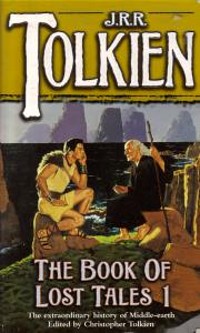Status
Call number
Genres
Collection
Publication
Description
Fantasy. Fiction. HTML: The Book of Lost Tales was the first major work of imagination by J.R.R. Tolkien, begun in 1916-17 when he was twenty-five years old and left incomplete several years later. It stands at the beginning of the entire conception of Middle-earth and Valinor, for these tales were the first form of the myths and legends that came to be called The Silmarillion. Embedded in English legend, they are set in the narrative frame of a great westward voyage over the Ocean by a mariner named Eriol (or AElfwine) to Tol Eressea, the Lonely Isle, where elves dwelt; from him they learned their true history, the Lost Tales of Elfinesse. In these Tales are found the earliest accounts and original ideas of Gods and Elves, Dwarves, Balrogs, and Orcs; of the Silmarils and the Two Trees of Valinor; of Nargothrond and Gondolin; of the geography and cosmology of Middle-earth. Volume One contains the tales of The Music of the Ainur, The Building of valinor, The Chaining of Melko, The coming of the Elves and The Flight of the Noldoli, among others. Each tale is followed by a short essay by Christopher Tolkien, the author's son and literary executor..… (more)
User reviews
Although the tales themselves are buttressed with copious notes on the source texts and their relationships to the Middle-Earth Tolkien canon, I admit I read little of that material. Instead, I offered the stories themselves aloud to my Other Reader as occasional bedtime reading. We both found the book enjoyable and satisfying that way. (On points where I had particular curiosity, I did read in the editorial apparatus that constitutes nearly half of the book.)
The content and imagery of these stories is very Dunsanian, reminiscent of stories like "The Fortress Unvanquishable Save for Sacnoth" and The King of Elfland's Daughter. But instead of Dunsany's lucid-if-ornate prose, we get the affected archaicisms of the aspiring English philologist. That certainly made this material a challenge to read aloud, but it was fun nevertheless. (I'm sure it didn't hurt that I've studied Middle English verse and enjoyed reading those texts aloud.) Reading this material as its own story, rather than a draft of what Tolkien was later to produce, is a pleasant enough experience. It may even be better than reading it with the hope of profound insights into the secrets of The Lord of the Rings, despite all of the younger Tolkien's efforts to facilitate such discoveries.
The BoLT blew my mind, especially Part I. These are Tolkien’s very early writings, before his concept of the world was fully developed. And wow, I’m very glad that he did develop it further. His elves were once decidedly closer to fairies and gnomes. He had an entirely different framework for telling these tales, one which he eventually (and in my opinion, rightly) discarded. Some of the concepts and ideas were very whimsical and childish (like “the cottage of lost play”) and don’t seem to fit Tolkien’s high-fantasy world.
Part II and the later sections of Part I are much closer to Tolkien’s finalized world. There are all sorts of familiar stories, not always “accurate” to published canon, but often with much more detail; most of these stories were revised and shortened before being added to the Silmarillion. The tales were not yet sewn together by the story of the Silmarils; the jewels were a side-story at best, and the Sons of Fëanor were not fully realized. I don’t think I appreciated how intricately Tolkien wove the Silmarillion together until I read BoLT.
Favorites: Glorfindel! He’s a side character at best, but one of my favorites. The BoLT contains the full narrative of the Fall of Gondolin, which is only summarized in the Silmarillion. Gondolin itself, while not a “character,” is one of my favorite sections, especially Tuor and Idril. I won’t lie; I broke out the sticky notes to mark Gondolin sections. The detailed variations on the creation story, the sun and moon, the trees, etc., were also wonderful. It was fascinating to watch the Silmaril narrative develop.
Least favorites: Oh god, Ælfwine.
Writing style: Tolkien paints a wonderfully full, detailed, high-fantasy world, full of fantastic characters and beautiful scenery. Lots of repeated themes: betrayal, greed, love, oaths, etc. Many of the stories seemed darker than in the Silmarillion, which I very much appreciated.
I recently had a friend (a reader and a fantasy fan) complain that Tolkien “interrupts” his story too often. I can see where she’s coming from; but to insist that side stories like the Entwives were interruptions and just bad writing, not world-building? This is what happens when you speed read through everything, children. ಠ_ಠ
Finally, you can’t tackle BoLT without warning: CHRISTOPHER TOLKIEN IS SUPER PEDANTIC. No criticism is intended; it’s just that he has taken great pains to present and interpret his father’s drafts, notes, corrections, re-writes, name changes, etc. etc. as accurately as possible. So be prepared to read (or skip through) his analysis and explanations for every section.
For Tolkien fans it is fascinating to see how these tales emerge. For a writer who is interested in world-building, it is a good way to see
It is, however, the most prized book in my collection, not because it is Tolkien, and not because it is a first edition, although both are true. This was the very first gift I recieved from my boyfriend, and is inscribed with a touching note, and houses the letters and notes he's written me, and call me a sentimental sap, but that is more than enough to launch it into the 5 star category for me. *blushes*
The one major gripe I have with BLT (the book, not the burger) is that there are no breaks between the fictional story and the
At least, that's the experience I had while reading my particular edition.
The Silmarillion in its earliest form. This is the first half, without the charismatic megafauna,
